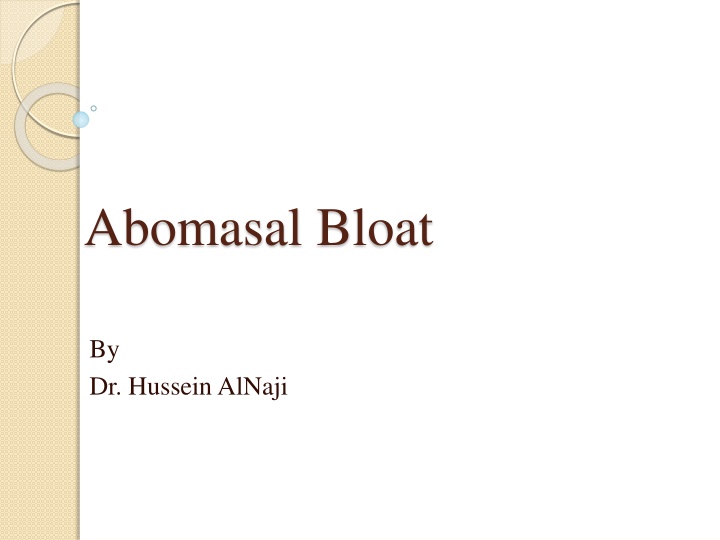
Abomasal Bloat in Calves: Causes, Clinical Signs, and Treatment
Abomasal bloat is a syndrome in young calves characterized by abdominal distention, anorexia, and a high mortality rate. Learn about the causes, clinical signs, and treatment options for this condition to help manage and prevent it in calves on dairy farms.
Download Presentation

Please find below an Image/Link to download the presentation.
The content on the website is provided AS IS for your information and personal use only. It may not be sold, licensed, or shared on other websites without obtaining consent from the author. If you encounter any issues during the download, it is possible that the publisher has removed the file from their server.
You are allowed to download the files provided on this website for personal or commercial use, subject to the condition that they are used lawfully. All files are the property of their respective owners.
The content on the website is provided AS IS for your information and personal use only. It may not be sold, licensed, or shared on other websites without obtaining consent from the author.
E N D
Presentation Transcript
Abomasal Bloat By Dr. Hussein AlNaji
Abomasal bloat is a syndrome in young calves characterized by anorexia, abdominal distention (either left sided or bilateral), and often death in 6 to 48 hours. This condition occurs most commonly in dairy calves and seems to have a sporadic occurrence with some farms having multiple outbreaks at times.
Causes 2- Roughage feeds. 1. Dietary changes. 2. Abomasal bezoars. 3. Copper deficiency. 4. Various microorganisms such as C. perfringens type A and Campylobacter Pathogenesis large amounts of fermentable carbohydrate present in the abomasum (from milk, milk replacer, or high-energy oral electrolyte solutions) along with the presence of fermentative enzymes (produced by bacteria) would likely lead to gas production and bloat.
Clinical signs 1. Acute abdominal distention, colic, depression, and sudden death have been reported in neonatal calves with abomasal ulcers, abomasitis. 2. Mild and may inconsistently include diarrhea.mild abdominal distention with fluid and gas, splashing on abdominal succession, and mild depression. Hyperglycemiawith an accompanying glucosuria consistently develop. Sequelae to abomasal dilation include 1. Abomasal torsion. 2. Perforation. 3. Rupture
Treatment 1. Generally involves placing the calf in dorsal recumbency and inserting a needle or catheter into the abomasum to relieve the gas. 2. Intravenous fluids are administered to correct dehydration, electrolyte, and metabolic derangements. 3. Antibiotic therapy may also be indicated in these calves (most likely parenteral procaine penicillin or oral -lactam antibiotics to target Clostridium bacteria).
